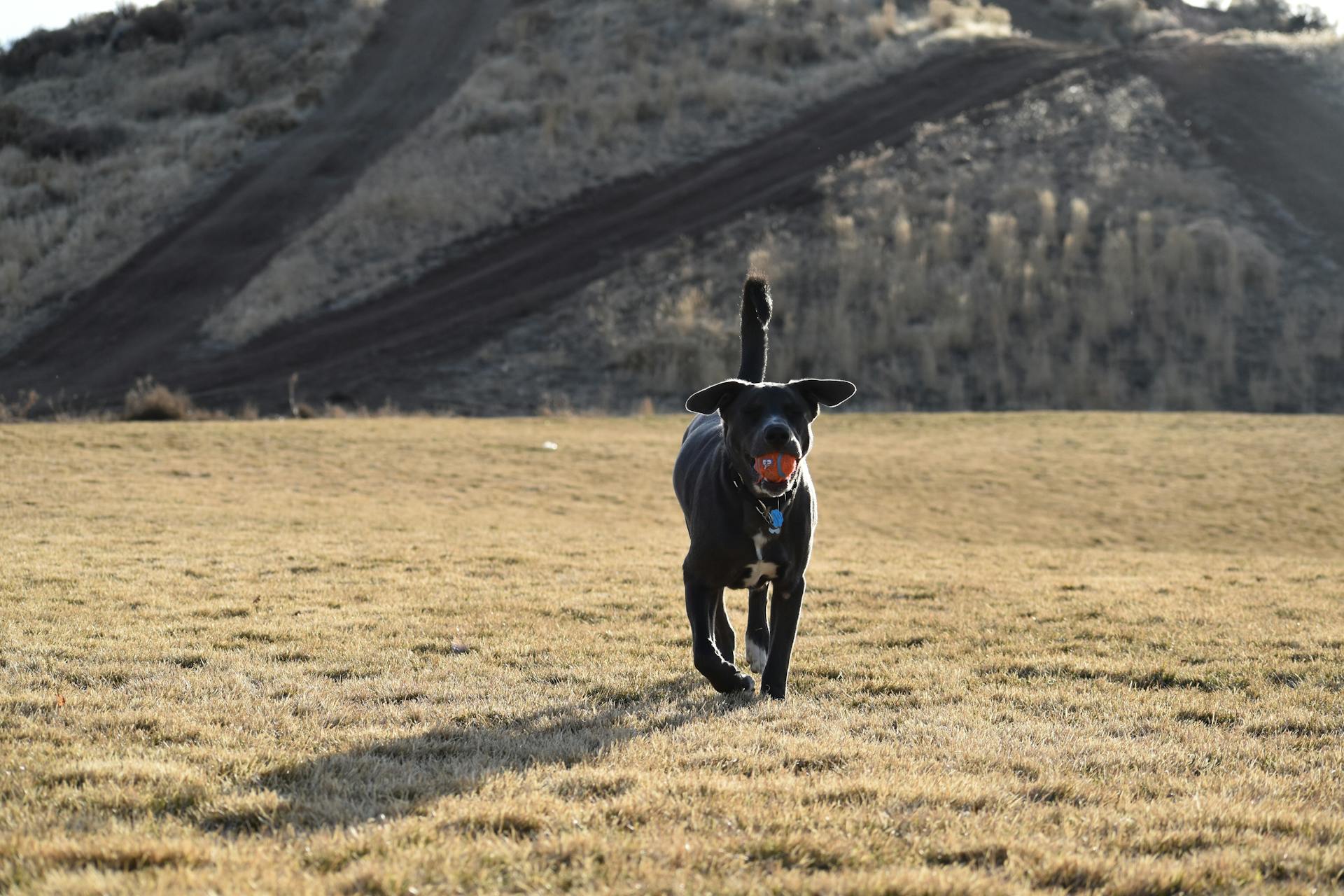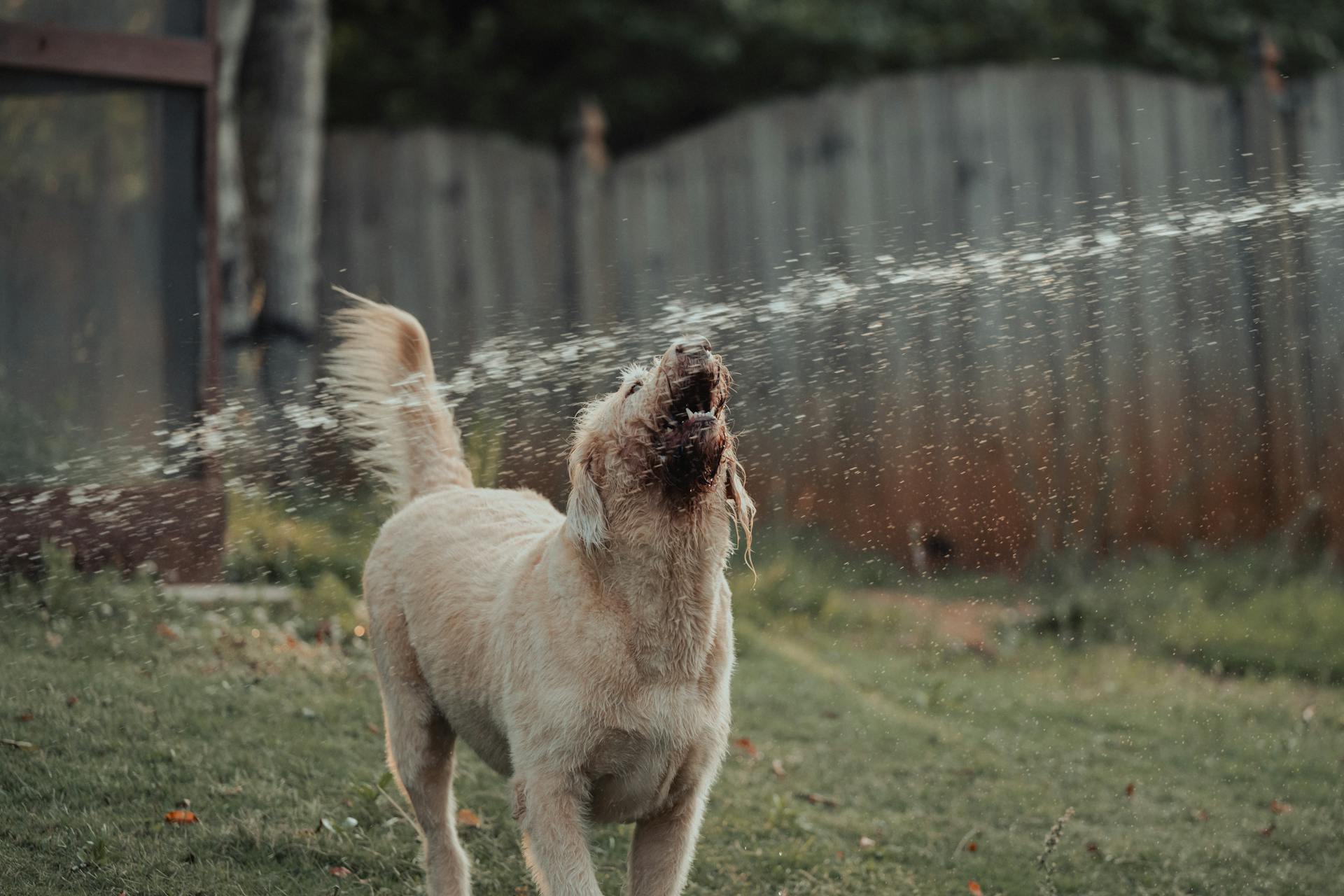
Training a hyper dog requires patience, consistency, and positive reinforcement. According to research, dogs with excess energy often have owners who are not providing enough physical and mental stimulation.
First, identify your dog's triggers for hyperactivity, such as overexcitement or boredom, and address them accordingly. This might involve creating a daily routine that includes regular exercise and playtime.
A tired dog is a calmer dog, so make sure to provide at least 30 minutes of moderate-intensity exercise per day. This can be as simple as a brisk walk or a game of fetch.
By understanding what drives your dog's hyperactivity and taking steps to address it, you can start to see improvements in their behavior.
Training Fundamentals
Training a hyper dog requires patience, consistency, and positive reinforcement. Start by burning off some energy with a game of fetch or a run around the yard before beginning a training session.
To begin, choose a quiet location with minimal distractions, such as a fenced yard or a quiet room inside. This will help your dog focus on the training.
See what others are reading: Training Dog to Stay in Yard
Teach your dog the "no" or "stop" command first, as it's essential for preventing unwanted behavior. Use a consistent command, either "no" or "stop", to avoid confusing your dog.
Basic commands like "sit", "come", "down", and "stay" are crucial for controlling your dog's behavior. These commands can also help keep your pet safer and make your life easier.
To teach your dog to sit, stand in front of it and place a treat in your hand, letting your dog see it in your palm. Firmly say "sit" while pushing the dog's rear end down until it sits, then give the treat and praise.
Reward your dog with treats and verbal praise when it follows a command correctly. Keep the training sessions short, around 5 minutes, and gradually increase the duration as your dog's focus improves.
Here's a list of essential commands to teach your hyper dog:
- No or stop
- Not to bite or chew
- Not to jump up on people
- Sit
- Down
- Stay
- Come
- Quiet
Remember, training takes time and patience, so don't get discouraged if your dog doesn't pick up a command right away. Stick with positive reinforcement and you'll see progress.
Positive Reinforcement
Positive reinforcement is a powerful tool in training a hyper dog. By focusing on what your dog is doing right, you can encourage good behavior and prevent unwanted actions.
Applying consistent exercises and training on a regular basis can prevent injuries and aggression. This is especially true for high-energy dogs that need to burn off excess energy.
Clicker training is a great way to start teaching obedience, and it's based on positive reinforcement. This method uses a handheld device that makes a clicking sound to signal good behavior.
Every time you click the device, be sure to reward your dog with a treat right after. This helps your dog associate the sound with a positive outcome.
Through clicker training, you can teach your dog to sit or lay down by clicking the device every time they obey your command. This can be an effective way to enforce positive behavior.
Additional reading: Why Use a Clicker for Dog Training
Exercise and Enrichment
Exercise and Enrichment are essential for hyper dogs. Daily physical exercise is guaranteed to calm them down, so set aside at least one hour a day for physical play.
You can try an unleashed dog park, a dog-friendly beach, or a walk through your neighborhood. A game of fetch in your backyard or a puppy play class can also be great options.
High-energy dogs need mental stimulation too. Invest in toys that dole out treats when your pet knocks them around or puzzle toys that challenge their mind. Hide treats around the room or toys around the yard and ask your dog to find them.
Agility-based exercises can also help channel your dog's energy. Try training your dog to perform exercises like jumps, tunnel exercises, weave pole training, and more. Once your dog is ready, create an obstacle course challenge that combines all the exercises they've already learned.
Some great enrichment activities for your dog include a long sniff walk, training, or a game of catch in the backyard. You can also try activities that speak to your dog's breed, such as trick training or digging pits for herding dogs.
Here are some breed-specific enrichment activities:
- Herding dogs (e.g. Border Collie, Aussie, Sheltie): trick training, agility training, digging pits, and herding balls
- Siberian Husky or Malamute: sniff walks, long hikes, exploration, hide and seek, long-distance walks, and training
- Terriers: digging pits, soft puzzle toys, snuffle mats, and agility courses
Remember, every dog is different, so experiment with different activities and games until you find something that clicks with your dog.
For more insights, see: Different Types of Dog Training
Managing Behavior
Managing behavior is the first step in training a hyper dog. It's essential to establish clear expectations and boundaries to help your dog understand what's expected of them.
To manage your dog's behavior, you can use tools like crates, leashes, and baby gates. For example, if your dog has a habit of jumping on guests, crate them until the guests arrive, then introduce them while leashed.
Time-outs can also be useful for managing behavior. A 5-20 minute timeout can give your dog time to settle and relax, helping them learn impulse control. This isn't meant to be a punishment, but rather a way to help your dog self-regulate.
You can also teach your dog to "relax on a mat" by laying on a mat when it's time to calm down. This can be a helpful training tool, and your dog may start using their mat when they feel overwhelmed.
Crate training is another effective way to help your dog stay calm. Start by getting a quality crate that's big enough for your dog to sit, stand, and turn around. Reward your dog for going near the crate, and eventually, they'll learn to associate it with good things.
Discover more: Dog Training Grass Mat
Here are some tips for managing behavior:
- Use a crate to help your dog stay calm
- Introduce a "relax on a mat" behavior to help your dog learn impulse control
- Use time-outs to help your dog self-regulate
- Keep a bag of treats handy to reward good behavior
- Only work on training for a few minutes at a time, two or three times a day, during the first few weeks of training
Equipment and Tools
You'll need a durable, high-quality crate for your pet that collapses and is easy to set up and transport. Supply the crate with a blanket or an orthopedic pet pad to make the space nice and snug.
A crate training aid that encourages licking has been proven to have a calming effect on dogs.
Kibble-Dispensing Toys
Kibble-dispensing toys are a great way to keep your dog engaged and stimulated. They require the push of a button or some other action to release a treat, challenging your dog's natural instincts.
These toys are designed to keep your pet fixated and ready for more. They're perfect for long sessions, and your dog will often top them off with a nice, long nap.
Kibble-dispensing toys also have a calming effect, especially when paired with enrichment tools that prompt your pet to keep licking.
Related reading: Dog Training with Toys
Crates
Crates can be a great way to help your dog channel their energy and be less hyperactive. They can function as a sanctuary where your dog can stew alone in peace and recharge.

Just make sure their crate has enough space for them to sit, stand, and walk around. A crate that's too small can be overwhelming for your dog.
A crate training aid that encourages licking has been proven to have a calming effect on dogs. This can be a great tool to help your dog love their home within a home.
It's essential to start slow and allow crate training to be a gradual process. Putting your dog in their crate several times throughout the day, even when you're home, will help them get used to it.
A high-quality crate that collapses and is easy to set up and transport can make crate training a breeze.
Recommended read: Will Neutering a Dog Help with Aggression
Harness
Harnessing your dog's energy is crucial for effective training. Exercise your dog before training to burn off nervous energy.
A good time to train is after a vigorous activity like running around the yard or a brisk walk. This will help your dog focus on you.
Suggestion: Positive Energy Dog Training

Short training sessions are key. Start with sessions under 5 minutes and gradually increase to 10 minutes as your dog becomes more focused.
Use reward-based training with your hyper dog. Positive reinforcement with treats or praise will yield the best results.
Here's a quick rundown of the training session duration:
Keep your commands short and sweet. One or two words are best to avoid confusing your dog.
Leash
Leash training is a great way to keep your dog from engaging in unwanted behavior. You can practice the "umbilical cord" technique, where you have your pooch permanently leashed to you throughout the day.
This technique is useful because you can consistently supervise your pet to reinforce positive behavior. Leashes and tethers are also good management tools, making it easier to keep your dog safe and under control.
A Healthy Diet
Feeding your hyper dog a healthy diet is crucial for their behavior and overall well-being. A high-quality food can help reduce unwanted behavior.
You might be tempted to save costs by choosing cheaper food brands, but beware of fillers, byproducts, coloring, and sugar that can be found in these options. These ingredients can have a direct impact on your dog's behavior.
Studies have drawn loose correlations between hyperactivity and certain dog food ingredients, so it's essential to choose a food that's free from these additives. This can help reduce your dog's hyperactivity and promote a more balanced behavior.
Consult your vet before making any changes to your dog's food, as they can help you choose the best option for your furry friend.
Recommended read: How to Stop Dogs Fighting over Food
Frequently Asked Questions
How do you calm down a hyper dog?
To calm down a hyper dog, try increasing exercise, using calming techniques like massage or supplements, or utilizing soothing elements like music or calming clothes. Start with simple methods and observe your dog's response to find the most effective solution.
How do you discipline a dog that won't listen?
To discipline a dog that won't listen, establish a consistent household routine and start with simple, distraction-free training sessions that reward good behavior. By being patient and gradually increasing distractions, you can help your dog learn to focus and obey commands.
Sources
- https://www.licksleeve.com/blogs/news/how-to-train-high-energy-dogs-to-calm-down
- https://www.diggs.pet/blog/pet-parenting/calm-down-hyper-dog/
- https://www.wikihow.com/Train-a-Hyper-Dog
- https://www.dogster.com/dog-training/how-to-calm-a-hyper-dog
- https://underdogslb.com/2023/03/07/relaxation-training-for-hyper-dogs-puppies/
Featured Images: pexels.com


